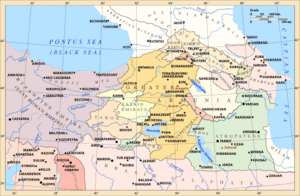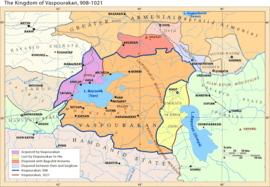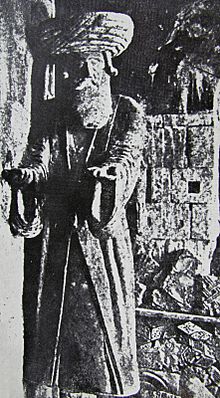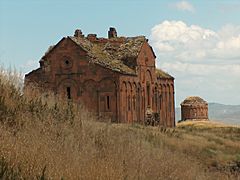Bagratid Armenia facts for kids
Quick facts for kids
Bagratid Armenia
|
|||||||||||||||
|---|---|---|---|---|---|---|---|---|---|---|---|---|---|---|---|
| 880s–1045 | |||||||||||||||

Bagratuni Armenia and other medieval Armenian kingdoms c. 1000
|
|||||||||||||||
| Status | Independent kingdom | ||||||||||||||
| Capital | Bagaran (885–890) Shirakavan (890–929) Kars (929–961) Ani (961–1045) |
||||||||||||||
| Common languages | Armenian | ||||||||||||||
| Religion | Armenian Apostolic | ||||||||||||||
| Government | Monarchy | ||||||||||||||
| Bagratuni Dynasty | |||||||||||||||
|
• 885–890
|
Ashot I | ||||||||||||||
|
• 890–914
|
Smbat I | ||||||||||||||
|
• 914–928
|
Ashot II | ||||||||||||||
| Historical era | Middle Ages | ||||||||||||||
|
• Established
|
880s | ||||||||||||||
|
• Disestablished
|
1045 | ||||||||||||||
| Currency | Byzantine Hyperpyron Abbasid Dinar |
||||||||||||||
|
|||||||||||||||
Bagratid Armenia (Armenian: Բագրատունիների թագավորություն) was an independent Armenian kingdom. It was founded by Ashot I Bagratuni in the early 880s. This happened after nearly 200 years of foreign rule by Arab empires.
At this time, two big powers, the Arabs and the Byzantines, were busy fighting each other. This gave Ashot a chance to lead a movement to free Armenia from Arab control. Both the Byzantines and Arabs wanted Armenia as a buffer state. They recognized Ashot as a powerful leader. The Arab Caliphate first called him "prince of princes" in 862. Later, they recognized him as king in 884 or 885.
The Bagratuni kingdom led to other Armenian kingdoms forming. These included Taron, Vaspurakan, Kars, Khachen, and Syunik. Under King Ashot III (952/53–977), Ani became the capital. It grew into a busy center for trade and culture.
However, the kingdom started to decline in the early 11th century. The Byzantine emperor Basil II took over parts of southwestern Armenia. King Hovhannes-Smbat agreed to give his lands to the Byzantines after he died. But when he passed away in 1041, his successor, Gagik II, refused. Gagik II fought back until 1045. His kingdom, weakened by problems inside and out, was finally taken by Byzantine forces.
History of Bagratid Armenia
How the Kingdom Began
In the 7th century, the Sassanian Empire became weak. This allowed the Muslim Arabs to rise as a new power. The Arabs started raiding Armenia in 640. Armenian leaders eventually agreed to be ruled by Muslims in 661. Armenia became a province called "al-Arminiya," with its capital at Dvin.
Arab rule became harsher in the early 8th century. This led to many revolts. In 705, the Arab governor tricked and killed many Armenian nobles. The Arabs tried to make peace, but high taxes and poor trade made things difficult. The Arabs also favored the Bagratuni family over other noble families.
Another rebellion happened when the Abbasids took over from the Umayyads. But it failed because the Armenian noble families fought among themselves. A final rebellion in 774 was crushed by the Arabs in 775. This left the Bagratuni family as the strongest remaining noble house.
The Bagratuni Family Rises
The Bagratuni family worked to improve their relationship with the Abbasid caliphs. By the 770s, the Bagratunis were seen as leaders of the Armenians. After the last rebellion, which the Bagratunis wisely stayed out of, they had no major rivals.
However, Arabs had moved into Armenia. The caliph also appointed emirs to rule new areas. But the number of Arabs was never a majority. The emirs were also not fully under the caliph's control. This divided Arab power, allowing the Bagratuni family to grow stronger. Ashot Msaker (the "Meat-Eater") led the family.
Ashot began taking over lands that used to belong to other noble families. He fought against the emirs to show his loyalty to the Caliphate. In 804, he was given the title of ishkhan (prince). When Ashot died in 826, his lands were split between his two sons.
Later, a new Armenian rebellion against Arab rule started in 850. But it failed. An Arab army captured many Armenian princes and put down the revolt.
Armenia Becomes a Kingdom
Things changed for Armenia in 867. The Armenian emperor of Byzantium, Basil I, won many battles against the Arabs. This weakened Arab control in Armenia. In 857, Ashot I became the leader of the Bagratunis. He slowly started taking back lands from the Arabs. In 862, he became "prince of princes."
Ashot was important to both the Byzantines and the Arabs. Byzantium wanted to secure its eastern border against the Arabs. Ashot promised his loyalty to the Byzantine Empire. In 884, the Caliph Al-Mu'tamid sent a crown to Ashot, recognizing him as king. The Byzantine emperor Basil also sent a crown. Ashot moved his capital to Bagaran. He was crowned king there in 884 or 885.
Ashot brought back the Armenian monarchy, which had been gone since 428. He made alliances with both the Byzantines and Arabs. But he chose to ally with the Byzantines in 885. Ashot was not the only Armenian prince, but other princes supported him as king. His power also extended to neighboring Georgia and Arab areas. Ashot died in 890, and his son Smbat I became king.
King Smbat I's Reign
Smbat I became king in 892. He continued his father's friendly relations with Byzantium. He also tried to ease Arab fears about the Armenian-Byzantine alliance. Smbat won a big victory in 892 when he took back the city of Dvin from the Arabs.
However, Smbat's success did not last. The Arab governor, Afshin, decided he could not allow a strong Armenia. He recaptured Dvin and took Smbat's wife hostage. Wars against Armenia continued even after Afshin died in 901. His brother, Yusuf, became the new Arab governor.
Smbat made some mistakes that caused his allies to turn against him. He gave the city of Nakhichevan to Smbat of Syunik. But this city was part of Gagik Artsruni's lands in Vaspurakan. Yusuf used this feud to his advantage. In 908, Yusuf gave Gagik a crown, making him King Gagik I of Vaspurakan. This created an Armenian kingdom that was against Smbat's rule.
Yusuf and Gagik started a new campaign against Smbat in 909. Neither the Byzantines nor the Caliph helped Smbat. Many Armenian princes also refused to help. Yusuf's army was very strong. Smbat finally surrendered to Yusuf in 914, hoping to stop the Arab attacks. But Yusuf killed Smbat.
Ashot Yerkat's Comeback
Yusuf's invasion left Armenia in ruins. Armenian princes were shocked by his cruelty. Gagik I of Vaspurakan turned against Yusuf. While Yusuf was busy fighting Gagik, Smbat's son Ashot II decided to become king. Ashot immediately began pushing the Muslims out of his lands.
Help for Ashot came from the Byzantine empress Zoe. She was worried about the Arab invasion of Armenia. In 914, Ashot visited Constantinople and was welcomed. A Byzantine army was sent to help Armenia defeat the Arabs. This army helped Ashot regain power and caused heavy losses for the Arabs.
Yusuf tried to weaken Ashot by crowning Ashot's cousin as king of Armenia. But this "anti-king" was defeated in 920. Ashot also put down other rebellions in Armenia. In 919, Yusuf was replaced by a new Arab governor, Subuk. Subuk recognized Ashot as the true ruler of Armenia. He gave Ashot the title of Shahanshah, or "king of kings."
The Byzantines became worried about Ashot's good relations with the Arabs. They sent a new force to challenge Ashot. But they failed to capture Dvin in 928. In 923, Yusuf was released and returned to Armenia. He demanded taxes from Armenian rulers but faced strong resistance from Ashot II. Ashot defeated Arab armies many times. In 929, Yusuf died. This led to power struggles among Iranian and Kurdish families, which reduced the Arab threat to Armenia. Ashot's efforts to protect his kingdom earned him the nickname "Yerkat," meaning "Iron." He died in 929 and was followed by his brother, Abas I.
Peace Under King Abas
King Abas I's rule brought a rare time of peace and wealth to Armenia. His capital was the city of Kars. Abas had many successes both at home and with other countries. In 929, he convinced the Arab governor of Dvin to release Armenian hostages. He also got control of the church palace back for Armenia.
There was little conflict with the Arabs during his reign. Abas was less friendly towards the Byzantines. They had often attacked Armenian lands. The Byzantine emperor was also busy fighting Arabs in Syria. This left Abas free to manage his kingdom without foreign interference.
Abas also faced an invasion from King Ber of Abkhazia in 943. Ber wanted a new church in Kars to follow Byzantine religious rules. Abas refused. He ambushed Ber's forces and captured the king. Abas then blinded Ber and sent him back to Abkhazia. Abas died in 953. His two sons, Ashot III and Mushegh, took over the kingdom.
Armenia's Golden Age
Ashot III became king of Armenia in 961. He moved the religious center to Argina, near the city of Ani. Many important people attended his crowning, including military leaders, bishops, and the king of Caucasian Albania. In the same year, Ashot moved the capital from Kars to Ani. The Bagratuni kings had moved their capital many times before. Ani's natural defenses and its location on a trade route made it a good choice.
Ani quickly grew into the main political, cultural, and economic center of Bagratid Armenia. Merchants built shops, markets, and inns. Rich nobles built grand houses and palaces. King Ashot also helped build many things. He built the famous "Ashotashen" walls around Ani. He also built monasteries, hospitals, schools, and places for the poor. His wife, Khosrovanuysh, founded the monasteries at Sanahin (966) and Haghpat (976). Ashot's support for these buildings earned him the nickname "Voghormats," meaning "the Merciful."
Ashot was also successful in foreign affairs. In 973, a Byzantine army entered Armenian territory. Ashot gathered an army of 80,000 men. He forced the Byzantines to leave. The next year, he made an alliance with the Byzantine emperor. He sent 10,000 Armenian troops to fight with the emperor against Muslim rulers. Ashot tried to capture Dvin from the Arabs in 953 but failed because the city was too strong.
Smaller Kingdoms Emerge
Under Ashot III, new smaller kingdoms started to appear within Bagratuni Armenia. Ashot III sent his brother Mushegh I to rule in Kars. He allowed Mushegh to use the title of king. The area of Dzoraget was given to Ashot's son Gurgen in 966. Gurgen later became king of that region.
Having many kingdoms was good for Armenia as long as the king in Ani was strong. He needed to maintain control over the other kings. Otherwise, these kings and their bishops might try to become more independent.
Growth Under Smbat and Gagik
Armenia's prosperous age continued under Ashot's son, Smbat II. Ani had grown so large by the time Smbat became king in 977. He ordered a second set of walls, called the Smbatashen walls, to be built around the city.
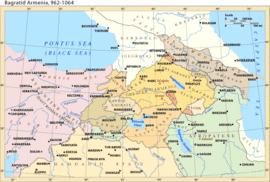
Decline and Byzantine Takeover
The Byzantines slowly moved eastward towards Armenia in the late 10th century. Emperor Basil II won many battles against the Arabs. This cleared the way for him to move into the Caucasus region. The Byzantine Empire believed that no Christian ruler should be independent of the Byzantine emperor. Their goal was to take over all Armenian lands.
By the mid-10th century, the Byzantine Empire was along Armenia's entire western border. Taron was the first Armenian region taken by the Byzantines. The Bagratuni princes of Taron were seen as Byzantine vassals. They had accepted titles and money from Constantinople. When Ashot Bagratuni of Taron died in 967, his sons could not resist the empire. The Byzantines took over their principality.
The Ardzruni kingdom of Vaspurakan was also taken later. In 1003, the last ruler, Senekerim-Hovhannes, faced attacks from Turkmen groups. In 1016, he offered to give his lands to Basil II. In return, he received a large area in Byzantine territory around the city of Sebastia. He moved there in 1021 with his family and many followers. Basil II had already sent an army to Vaspurakan. They made it another Byzantine province. With the fall of Vaspurakan, Byzantine power was strong in the Armenian highlands. Only the Bagratuni and Eastern Syunik and Baghk kingdoms remained independent.
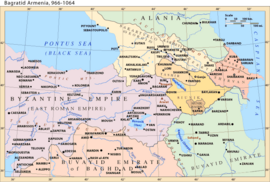
Internal Fights and the Fall of the Kingdom
After King Gagik I died (around 1017 or 1020), the kingdom was split between his two sons. Hovhannes-Smbat received the area of Ani. Ashot IV the Brave received another territory. The two brothers fought throughout their lives.
Hovhannes-Smbat, who had no children, sent the catholicos Petros Getadarts to Byzantium. He wanted to make a deal to leave his kingdom to the empire after his death. After both brothers died in 1040–41, the new Byzantine emperor claimed the Bagratid Armenian kingdom.
Ashot's son, young Gagik II, became king for only two years. He had the support of his military leader, Vahram Pahlavouni. Gagik II was able to fight off a Turkmen attack. However, he accepted an invitation from Emperor Constantine IX to Constantinople. There, he was forced to give his kingdom to the empire. In return, he received land in Cappadocia.
In 1044, the Byzantines attacked Ani twice but failed to capture it. The catholicos Petros Getadarts, who was governing Ani in the king's absence, surrendered Ani to the Byzantines in 1045. Ani was then added to the Byzantine province of Iberia.
The Bagratid king of Kars, Gagik-Abas, kept his throne even after Ani fell to the Seljuk Turks in 1064. But he too was forced to give his lands to the Byzantines. He moved to Anatolia. Kars was then captured by the Turks in 1065. In Baghk and Eastern Syunik, only a few Armenian fortresses remained.
Culture and Society
Government Structure
The king of Bagratuni Armenia had great power. He made all the final decisions on foreign and local matters. Princes and nobles were directly under the king. They could only keep their lands with his permission. If nobles disobeyed, the king could take their lands and give them to others. However, the idea of "divine right" (that a king's power comes directly from God) did not exist. A king's power depended on his own strength.
Religion in Armenia
Most Armenians belonged to the Armenian Apostolic Church. But some people followed the Eastern Orthodox Church, which was the official religion of the Byzantine Empire. Byzantium often asked the Armenian Church to join them. This was a condition for sending help to the Bagratunis. But most attempts failed.
In the mid-10th century, a new challenge to the Armenian Church and kingdom appeared. The Tondrakians, a Christian group that had been suppressed, became active again. This group attracted many followers. Ashot III realized the danger the Tondrakians posed. This was one reason he put the Church directly under his control. He gave it land and supported building new monasteries and churches. However, the Tondrakian message continued to spread. Later Armenian kings also tried to stop its growth.
Armenia's Economy
The Bagratuni kingdom had two main types of economies. One was based on agriculture and feudalism. The other focused on mercantilism (trade) in towns and cities. Peasants, called ramiks, were the lowest class. They mostly raised livestock and farmed. Many did not own land. They worked as tenants or hired hands on lands owned by rich lords. Peasants had to pay high taxes to the government, the Church, and their feudal lords. Most peasants remained poor. The heavy taxes sometimes led to peasant uprisings, which the state had to put down.
The Bagratuni kingdom did not make its own coins. They used money from Byzantium and the Arab Caliphate. Trade routes between Byzantium and the Caliphate crossed Armenia. The most important route went from Trebizond to Ani, Kars, and Artsn. Kars allowed trade to go north to the Black Sea and Abkhazia. Other routes connected to cities in Anatolia and Iran. The main route from the Caliphate to Kievan Rus was called the "Great Armenian Highway." Ani became an important trading hub because of its size, power, and wealth.
Armenia exported textiles, metalwork, armor, jewelry, horses, cattle, salt, wine, honey, timber, leather, and furs. Their main trading partners were the Byzantine Empire and the Arabs. They also traded with Kievan Rus and Central Asia. Dvin, with its Armenian population, remained an important city like Ani. The Arab historian al-Mukadasi described Dvin as a rich city with famous cloth and many gardens.
Dvin was known in the Arab world for its wool and silk. It also exported pillows, rugs, and curtains. A village near Dvin was famous for making Armenian cochineal. This was a distinctive red dye from insects. Armenian goods were widely found throughout the caliphate. Arabs called them "asfin al-Armani" ("Armenian products").

Population of Armenia
During the Bagratuni period, most people in Armenia were Armenian. Arab sources from the 10th century say that cities in the Araxes valley were mostly Armenian and Christian. This was true even under Arab Muslim rule. The Arab geographer Ibn Hawqal noted that Armenian was spoken in Dvin and Nakhichevan. However, there were also Muslims in some parts of Armenia. For example, the southern region of Aghdznik had many Arabs from earlier times. There was also a notable Muslim population on the north shore of Lake Van in the 9th and 10th centuries.
Art and Literature Flourish
Arab raids and wars had stopped Armenian culture from growing in areas like history, literature, and architecture. But these limits disappeared when the Bagratuni kingdom was formed. This started a new golden age for Armenian culture.
With fewer Arabs present, more historians appeared. They wrote about Armenia's relations with other countries. They also described many events from the 7th to 11th centuries. Kings and nobles supported monasteries. These monasteries became centers for studying and writing literature. The monasteries of Haghpat and Sanahin were famous centers for learning. Important figures in Armenian literature and philosophy from this time include the mystic Grigor Narekatsi and Grigor Magistros.
The art of illuminated manuscripts and miniatures (small illustrations) also came back during this time. The peace between Byzantium and Armenia in the late 10th century led to artists from both cultures working together. Armenian manuscript artists often showed the human body naturally. Or they focused on decorative elements.
Armenian architecture was especially important during the Bagratuni era. Most of the churches still standing in Armenia today are from this period. The city of Ani grew commercially and culturally in the 9th century. It was on an important trade route. Ani became famous for its "40 gates and 1,001 churches." Churches from this period were often taller. They included portraits of donors and ideas from Byzantine and Islamic architecture. Armenian churches were always built of stone. They had vaulted ceilings that supported a round dome. Many churches were damaged or destroyed after the Seljuk invasions in the 11th and 12th centuries.
Images for kids
-
Bagratid Armenia and neighboring Armenian states of Vaspurakan, Taron, Syunik-Baghk, Khachen, etc.
-
Bagratid Armenia, annexed by the Byzantine Empire and Syunik
-
The Cathedral of Ani, completed in 1001 by Trdat the Architect
-
A portrait of Grigor Narekatsi from an 1173 illuminated manuscript
See also
 In Spanish: Armenia bagrátida para niños
In Spanish: Armenia bagrátida para niños
- Bagrationi dynasty
- Bagratuni dynasty
- Kars
- Kingdom of Georgia
- Kingdom of Tashir-Dzoraget
- Kingdom of the Iberians
- Kingdom of Vaspurakan
- Principality of Khachen
- Taron (historic Armenia)



